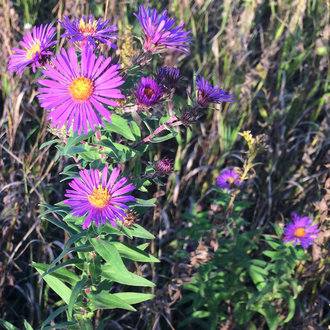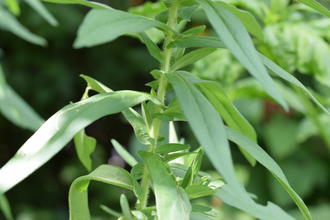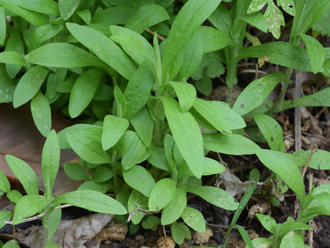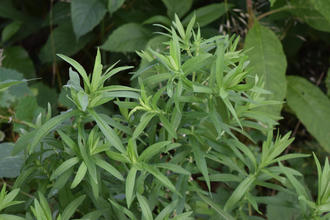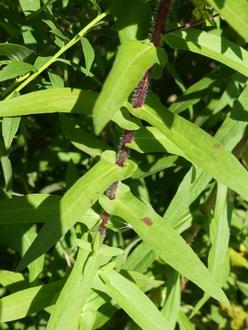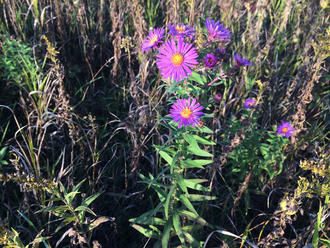New England Aster (Symphyotrichum novae-angliae (L.) G.L. Nesom)
Also known as Aster novae-angliae L..
↑Summary
A purple-flowering perennial of average to moist, sunny areas in eastern North America.
↑Range - Expand
| Legend | Color |
| Native | |
| Introduced | |
| Native or Not Present | |
| Introduced or Not Present | |
| Native or Introduced or Not Present |
This tentative map is based on our own research. It may have limited data on Canada and/or Mexico, and there is some subjectivity in our assignment of plants as introduced vs. expanded. Read more in this blog post.
Although this plant occurs somewhere in each of these regions, it may only occur in a small part of some or all of them.
↑Description & Identification
Perennial with a clumping habit, stems up to 2m tall, usually. Stems and leaves hairy; leaf bases conspicuously clasp stem. Composite flowers with yellow centers and (usually) purple or purplish rays. Extensive variation in ray color from pale pink to lavender to deep purple.
↑Habitat
Found in mesic to moist, open habitats and borders. Natural habitats include prairies and meadows, especially in floodplains, and sunny woodland edges and clearings, especially edges along bodies of water and open wetlands. Anthropogenic habitats include moist abandoned fields, roadsides and railroads, and waste ground. Found in both degraded anthropogenic habitats and high-quality natural areas.
Prefers soils good at retaining water, with textures ranging from loamy to clay, so long as soils are at least somewhat well-drained. Tolerant of consistently moist and temporarily waterlogged soils, but not of deep flooding or persistently waterlogged soils. Tolerates slightly drier soils in the north of its range. More frequent on calcareous soils, and increasingly restricted to calcareous soils in the south of its range.
Temporarily colonizes early successional habitats following a disturbance and persists for several years, but is eliminated as it becomes shaded by trees. Persists long-term only on sites where local conditions or regular disturbance maintain high-light conditions long-term.
↑Life Cycle
Seedlings germinate in spring, after a period of cold dormancy, with a few plants continuing to germinate into early summer under cooler conditions. As seeds are small, seedlings are not competetive with established perennials and usually require at least a small area of exposed conditions to establish.
Plants usually only reach a fraction of their mature height during the first year, often only a few feet tall, and usually producing only one stem. These plants usually flower, but only produce a small number of blooms.
With subsequent years, the plant grows taller and grows more stems. Short rhizomes rarely travel more than a few inches from the parent plant, creating a clumping growth habit. Tall stems initially grow straight, but often do not support their own weight; they will grow upright if supported by other plants, but will often flop over in late summer if grown in an exposed area, or sooner if high-moisture conditions leads to rapid, heavier growth. Established plants are competetive with herbaceous vegetation of similar height, and often grow taller in response to competetition, but compete poorly with taller woody plants.
In moist conditions, this plant can retain nearly all its leaves throughout the season, but in drier conditions it loses most of its lower leaves by the time of flowering. Plants are good at withstanding temporary drought due to weather patterns, but will get out-competed by more drought-tolerant vegetation on persistently dry sites.
Flowers are insect-pollinated and are self-infertile: they must be cross-pollinated to produce viable seeds. Seeds are wind-dispersed. In a typical year on typical sites, only a small portion of seeds are viable, but viable seeds can persist in the seed bank for several years.
Contrasting with some species that have only a few specific color morphs, this species has continuously variable flower color, and over time, pollination pressure will select for as broad a range of colors as possible so long as those colors are visually distinct from other flowers occurring in the same habitat and blooming at the same time. Thus, the color range will tend to be broader in habitats where there are few other purple-to-pink flowers blooming at the same time, and narrower (and far from other flowers) when there are overlapping flowers of similar colors.
↑Faunal Associations
Overall, this species is good at supporting wildlife, especially through supporting a large diversity of insects.
Mammalian herbivores, including deer, rabbit, and livestock, will all browse this plant, usually not preferring it due to its fuzzy foliage, but eating it to the ground if better food is not available, as it is not particularly toxic to mammals.
The flowers attract a variety of pollinators, including long-tongued bees (bumblebees, honeybees, miner bees, and larger leaf-cutting bees), butterflies, and skippers, which pollinate the flowers, and short-tongued bees and syrphid flies, which collect pollen but not nectar, and are not effective pollinators.
There are many moths that eat this plant in their larval stage, including Phaneta tomonana and Phtheochroa marloffiana, which may specialize on this species, the camphorweed cucullia (Cucullia alfarata), gorgone checkerspot (Chlosyne gorgone), and pearl crescent (Phyciodes tharos), Phycitodes albatella, and Asymmetrura impositella, which eat plants in the aster family, the northern flower moth (Schinia septentrionalis), and Phaneta essexana, which eat plants of this genus, and the generalists alfalfa webworm (Loxostege commixtalis), Clemens' clepsis moth (Clepsis clemensiana), blueberry leafroller (Sparganothis sulfureana), and Xenotemna pallorana. It is also eaten by Sonia canadana, of which relatively little is known.
It is also eaten by the generalist tarnished plant bug (Lygus lineolaris) and fourlined plant bug (Poecilocapsus lineatus), and by the chrysanthemum lace bug (Corythucha marmorata) and the potato aphid (Macrosiphum euphorbiae).
↑Uses
New England Aster is sometimes cultivated in gardens, where it is valued for its showy flowers which average a bold purple color, but come in a wide variety of shades. Its use in gardens is somewhat limited by its tendency to flop over in the absence of supporting vegetation, and by its poor appearance in dry conditions. Some cultivars exist, including both those taken from wild populations and not appreciably different, and those bred to have compact growth habits unlike those in wild populations.
Frequently used in habitat restoration and seed mixes to revegetate disturbed areas and stabilize soil, where it is valued for its adaptability, support of wildlife, competetiveness against invasive plants, and aesthetic qualities. It establishes readily by seed and also transplants well.
↑Related Plants
This aster co-occurs with numerous other species of the Symphyotrichum genus. A 2012 analysis concluded that the most likely closest relatives were scaleleaf aster (Symphyotrichum adnatum), aromatic aster (Symphyotrichum oblongifolium), and late purple aster (Symphyotrichum patens). eastern silver aster (Symphyotrichum concolor), white heath aster (Symphyotrichum ericoides), and barrens silky aster (Symphyotrichum pratense) are also likely closely related.
It hybridizes with S. ericoides to produce the amethyst aster (Symphyotrichum ×amethystinum), which occurs in the wild through much of the zone of overlap of these species, and is most common in New England. No other hybrids are known to occur.
↑Notes
Although some sources list "Michaelmas daisy" as a common name for this species, that term is vague and refers broadly to many visually-similar purple-flowering species including both other Symphyotrichum species, and those in related genera such as Aster. As such we do not consider that a common name for this species but rather an ill-defined term that refers broadly to any purple-flowering asters; we recommend avoiding the term because of its ambiguity.
↑Links & External Resources
• Symphyotrichum novae-angliae (New England Aster) | Illinois Wildflowers (About This Site)
• Symphyotrichum novae-angliae (New England Aster) | USDA PLANTS Database (About This Site)
• Symphyotrichum novae-angliae | Go Botany (About This Site)
• Symphyotrichum novae-angliae (New England Aster) | Missouri Botanical Garden Plant Finder (About This Site)
• Symphyotrichum novae-angliae | Biota of North America Project (BONAP) (About This Site)
• Symphyotrichum novae-angliae | NatureServe Explorer (About This Site)
• Symphyotrichum novae-angliae | Flora of North America (About This Site)
• Symphyotrichum novae-angliae | Missouri Plants (About This Site)
• New England Aster | Maryland Biodiversity Project (About This Site)
• Symphyotrichum novae-angliae (New England Aster) | Minnesota Wildflowers (About This Site)
• Symphyotrichum novae-angliae (L.) Nesom (New England Aster) | Digital Atlas of the Virginia Flora (About This Site)



